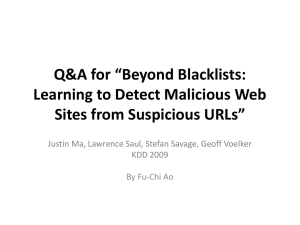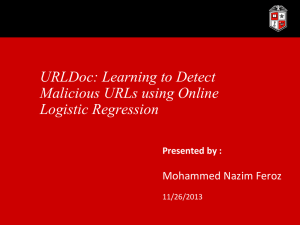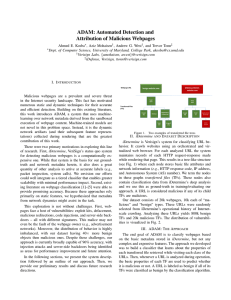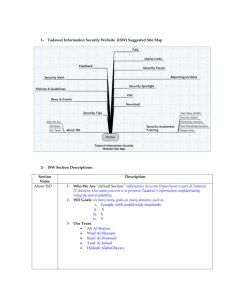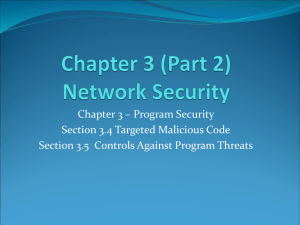Prophiler: A fast filter for the large
advertisement
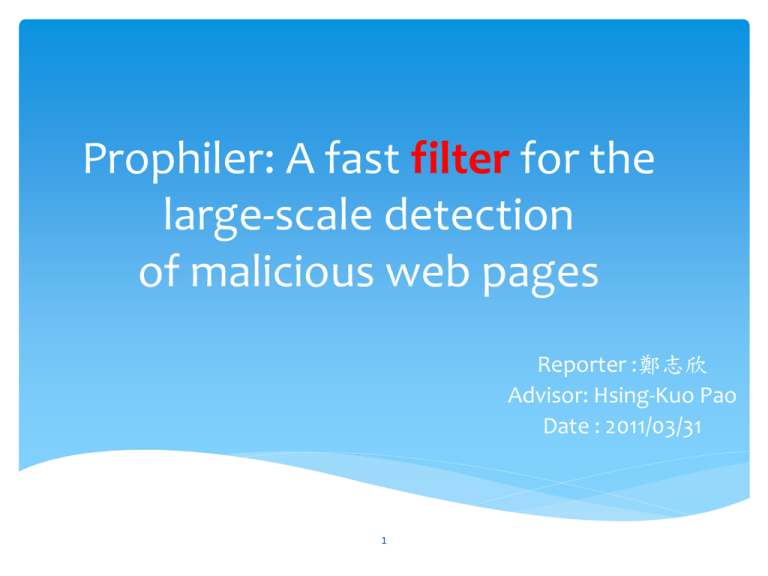
Prophiler: A fast filter for the large-scale detection of malicious web pages Reporter :鄭志欣 Advisor: Hsing-Kuo Pao Date : 2011/03/31 1 Conference • Davide Canali, Marco Cova, Giovanni Vigna and Christopher Kruegel,"Prophiler: a Fast Filter for the Large-Scale Detection of Malicious Web Pages",20th International World Wide Web Conference (WWW 2011) 2 Outline Introduction Approach Implementation and Setup Evaluation Conclusion 3 Intruduction • Malicious Web pages – Drive-by-Download : JavaScript – Compromising hosts – Large-scare Botnets • Static analysis vs. Dynamic analysis – Dynamic analysis spent a lot of time. – Static analysis reduce the resources required for performing large-scale analysis. – URL blacklists (Google safe Browsing) – HoneyClient: Wepawet PhoneyC JSUnpack – Combined ? • Quickly discard benign pages forwarding to the costly analysis tools(Wepawet). 4 Prophiler Prophiler, uses static analysis techniques to quickly examine a web page for malicious content. HTML , JavaScript , URL information Model : Using Machine-Learning techniques 5 Approach Features Neko HTML Parser HTML, JavaScript,URL information Total features : 77 New features : 17 Models 6 Features 7 Reference Paper • [26]C. Seifert, I. Welch, and P. Komisarczuk. Identification of Malicious Web Pages with Static Heuristics. In Proceedings of the Australasian Telecommunication Networks and Applications Conference (ATNAC), 2008. • [16] P. Likarish, E. Jung, and I. Jo. Obfuscated Malicious Javascript Detection using Classification Techniques. In Proceedings of the Conference on Malicious and Unwanted Software (Malware), 2009 • [6] B. Feinstein and D. Peck. Caffeine Monkey: Automated Collection, Detection and Analysis of Malicious JavaScript. In Proceedings of the Black Hat Security Conference, 2007. • [17] J. Ma, L. Saul, S. Savage, and G. Voelker. Beyond Blacklists: Learning to Detect Malicious Web Sites from Suspicious URLs. In Proceedings of the ACM SIGKDD International Conference on Knowledge Discovery & Data Mining, 2009. • [25] C. Seifert, I. Welch, and P. Komisarczuk. Identification of Malicious Web Pages Through Analysis of Underlying DNS and Web Server Relationships. In Proceedings of the LCN Workshop on Network Security (WNS), 2008. 8 Effectiveness of new features HTML(7) JavaScript(4) URL and Host(5) #elements containing suspicious content shellcode presence probability(J48) TLD of the URL #iframes the presence of decoding routines the absence of a subdomain in the URL #elements with a small area the maximum string length the TTL of the host’s DNS A record the whitespace percentage of the web page the entropy of the scripts the presence of a suspicious domain name or file name the page length in characters the presence of a port number in the URL the presence of meta refresh tags the percentage of scripts in the page 9 Discussion Assumptions First, distribution of feature values for malicious examples is different from benign examples. Second, the datasets used for model training share the same feature distribution as the real-world data that is evaluated using the models. Trade-offs False negative vs. False positive 10 Implementation and Setup(cont.) • Prophiler as a filter for our existing dynamic analysis tool, called Wepawet. • Collection URLs : Heritrix (tools), Spam Email • Terms form Twitter , Google , Wikipedia trends • Collecting URLs : 2,000 URLs/day 11 12 Implementation and Setup • The crawler fetches pages and submits them as input to Prophiler. • Server : – Ubuntu Linux x64 v 9.10 – 8-core Intel Xeon processor and 8 GB of RAM • The system in this configuration is able to analyze on average 320,000 pages/day. • Analysis must examine around 2 million URLs each day. 13 Evaluation Total web pages : 20 million web pages. 14 Evaluation (cont.) • Training Set : – – – – 787 Wepawet’s database. 51,171 Top100 Alexa website Google safebrowsing API ,anti-virus ,experts. 10-Fold 15 16 Evaluation (cont.) • Validation – – – – – – – 153,115 pages Submitted to Wepawet spent 15 days Benign : 139,321 pages Malicious : 13,794 pages False Positive : 10.4% False Negative : 0.54% Saving valuable resources 17 18 Evaluation (cont.) Large-scale Evaluation 18,939,908 pages run 60-days 14.3% as malicious 85.7% as reduction of load on the back-end analyzer 1,968 malicious pages/days (by Wepawet) False Positive rate : 13.7% False Negaitve rate : 1% 19 1968 every day as malicious by Wepawet 20 Evaluation (cont.) Comparsion 15000 web pages Malicious : 5861 pages Benign : 9139 pages 21 Conclusion We developed Prophiler, a system whose aim is to provide a filter that can reduce the number of web pages that need to be analyzed dynamically to identify malicious web pages. Deployed our system as a front-end for Wepawet , with very small false negative rate. 22
